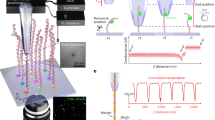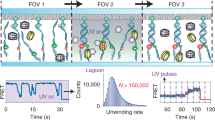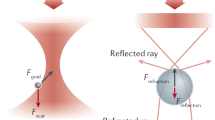Abstract
Techniques for measuring the motion of single motor proteins, such as FRET and optical tweezers, are limited to a resolution of ∼300 pm. We use ion current modulation through the protein nanopore MspA to observe translocation of helicase Hel308 on DNA with up to ∼40 pm sensitivity. This approach should be applicable to any protein that translocates on DNA or RNA, including helicases, polymerases, recombinases and DNA repair enzymes.
This is a preview of subscription content, access via your institution
Access options
Subscribe to this journal
Receive 12 print issues and online access
$209.00 per year
only $17.42 per issue
Buy this article
- Purchase on Springer Link
- Instant access to full article PDF
Prices may be subject to local taxes which are calculated during checkout


Similar content being viewed by others
References
Ha, T., Kozlov, A.G. & Lohman, T.M. Annu. Rev. Biophys. 41, 295–319 (2012).
Kim, H. & Ha, T. Rep. Prog. Phys. 76, 016601 (2013).
Kasianowicz, J.J., Brandin, E., Branton, D. & Deamer, D.W. Proc. Natl. Acad. Sci. USA 93, 13770–13773 (1996).
Manrao, E.A. et al. Nat. Biotechnol. 30, 349–353 (2012).
Cherf, G.M. et al. Nat. Biotechnol. 30, 344–348 (2012).
Butler, T.Z., Pavlenok, M., Derrington, I.M., Niederweis, M. & Gundlach, J.H. Proc. Natl. Acad. Sci. USA 105, 20647–20652 (2008).
Laszlo, A.H. et al. Nat. Biotechnol. 32, 829–833 (2014).
Smith, S.B., Cui, Y. & Bustamante, C. Science 271, 795–799 (1996).
Bosco, A., Camunas-Soler, J. & Ritort, F. Nucleic Acids Res. 42, 2064–2074 (2014).
Woodman, I.L.B. & Bolt, E.L. Biochem. Soc. Trans. 39, 140–144 (2011).
Büttner, K., Nehring, S. & Hopfner, K.-P. Nat. Struct. Mol. Biol. 14, 647–652 (2007).
Myong, S., Bruno, M.M., Pyle, A.M. & Ha, T. Science 317, 513–516 (2007).
Herbert, K.M., Greenleaf, W.J. & Block, S.M. Annu. Rev. Biochem. 77, 149–176 (2008).
Laszlo, A.H. et al. Proc. Natl. Acad. Sci. USA 110, 18904–18909 (2013).
Adam, G. & Delbruck, M. in Structural Chemistry and Molecular Biology (eds. Rich, A. & Davidson, N.) 198–215 (W.H. Freeman & Co., 1968).
Mathé, J., Visram, H., Viasnoff, V., Rabin, Y. & Meller, A. Biophys. J. 87, 3205–3212 (2004).
Henrickson, S.E., Misakian, M., Robertson, B. & Kasianowicz, J.J. Phys. Rev. Lett. 85, 3057–3060 (2000).
Akeson, M., Branton, D., Kasianowicz, J.J., Brandin, E. & Deamer, D.W. Biophys. J. 77, 3227–3233 (1999).
Derrington, I.M. et al. Proc. Natl. Acad. Sci. USA 107, 16060–16065 (2010).
Schreiber, J.M. & Karplus, K. bioRxiv http://biorxiv.org/content/early/2015/01/23/014258 (2015).
Acknowledgements
This work was supported at the University of Washington by the National Institutes of Health National Human Genome Research Institute (NHGRI) grant R01HG005115 and at Illumina through internal funding. We thank J.J. Bartlett, S. Klebanoff, M.T. Svet and M.T. Noakes for assisting in the data collection and C.-Y. Chen, A. Nikoomanzar and W. Chang for making Hel308 and testing its activity. M. Hopper, N. Sam-Soon and S. Marx performed the initial experiments that revealed Hel308’s fractional steps and their ATP dependence.
Author information
Authors and Affiliations
Contributions
I.M.D., J.M.C., E.S., A.H.L., I.C.N., J.G.M., K.L.G. and J.H.G. designed experiments. J.M.C., H.B., I.C.N., K.D. and B.I.T. performed the research. I.M.D., J.M.C., E.S., A.H.L., B.C.R., H.B. and J.H.G. analyzed the data. I.M.D., J.M.C., A.H.L., J.H.G. wrote the paper. M.R., K.L.G. and J.H.G. led the research teams.
Corresponding author
Ethics declarations
Competing interests
E.S., M.R., J.G.M. and K.L.G. are employed by Illumina, Inc. J.H.G. is a paid part-time consultant for Illumina. E.S., M.R., J.G.M., K.L.G. and J.H.G. hold Illumina stock. One or more embodiments of one or more patents and patent applications filed by the University of Washington and Illumina may encompass the methods, reagents and the data disclosed in this manuscript. Some work in this study is related to technology described in patent applications.
Integrated supplementary information
Supplementary Figure 1 Schematic of experimental setup.
(a) Side view of experimental apparatus. A Teflon tube filled with KCl solution connects two wells, labeled cis and trans, also filled with KCl solution. The cis well is connected to negative terminal of the amplifier (ground) via a Ag/AgCl electrode while the trans well is connected to an Axopatch amplifier that supplies the driving voltage. The output of the amplifier is then filtered and digitally sampled. (b) Expanded view of the cis end of the Teflon tube. A bilayer is established upon the 20 µm aperture as described in to the Online Methods.
Supplementary Figure 2 Example of temporal resolution of SPRNT.
Raw data (grey) and automatically found level medians (black) for a phi29 DNAP moving sequence B through MspA. Notice that current levels less than 1 ms in duration are well defined and resolvable. Generally during phi29 DNAP progression along DNA, levels were greater than 1 millisecond in duration.
Supplementary Figure 3 Examples of DNA repositioning.
(a) As in Fig. 1h, we plot current levels taken at different voltages (indicated by symbols within the legend). Because current scales with voltage, we apply a linear scale and offset to the values so we can easily compare their current level patterns. To account for the DNA shifting positions under different applied forces we add a horizontal offset. A spline of the 180 mV current values is shown in black dashes. The predictive ability of the spline for the 180 mV levels illustrates that the different voltages reposition DNA within MspA’s constriction. (b) The voltage-induced changes to the DNA’s contour length normalized by the length at 160 mV plotted against the applied voltage normalized by 160 mV. We model the DNA’s elongation as an extensible freely jointed chain (Ex-FJC) (dashed line) and fit it to the observed elongation ratios, as further discussed in the Supplementary Discussion 1. While the Ex-FJC is derived for DNA in non-confined areas, for the forces that we are applying (~20-40 pN) the single parameter model describes the data well and suggests that the DNA repositioning within the pore is due to DNA elongation.
Supplementary Figure 4 Sequence B consensus
A combination of information in Figures 2a, 2b, 2e and 2f of the main text but for DNA sequence B. (a) The observed level patterns for phi29 DNAP moving sequence B through MspA. Data was taken with 150 mM [KCl] in the cis well and 500 mM [KCl] in the trans well. (b) The observed level patterns for Hel308 translocating DNA sequence B through MspA (black lines). The automatically generated consensus levels for sequence B are aligned to the sequence and level pattern found for phi29 DNAP. Data was taken with 400 mM [KCl] buffers in both cis and trans wells. The difference in salt conditions accounts for the difference in current values between (a) and (b). A gap indicates a position where a level was missing due to degeneracy. (c) The number of times that a given level shown in (b) was observed. (d) The median duration of the levels with the current shown in (b) while using 10 and 50 µM [ATP] (black line) and using 1 mM [ATP] (red line). Level durations depend partially on sequence context. (e) Ratio of level durations for observations using low [ATP] (10 and 50 µM) and for high [ATP] (1 mM). We indicate odd-numbered levels that depend on [ATP] with an orange diamond and even-numbered levels that do not depend on [ATP] with a blue circle. Levels that could not be identified as ATP-dependent or independent due to degeneracy of nearby current values are indicated with a red ‘x’. Comparing the duration at different values of [ATP] removes level-duration dependence on sequence context.
Supplementary Figure 5 Sequence C consensus
A combination of information in Figures 2a, 2b, 2e, and 2f of the main text but for DNA sequence C. (a) The observed level patterns for phi29 DNAP moving sequence B through MspA. The sequence was designed to have repeating pattern with high contrast between adjacent current levels. Data was taken with 150 mM [KCl] in the cis well and 500 mM [KCl] in the trans well. (b) The observed level patterns for Hel308 translocating DNA sequence C through MspA (black lines). The automatically generated consensus levels for sequence C are aligned to the sequence and level pattern found for phi29 DNAP. Data was taken with 400 mM [KCl] buffers in both cis and trans wells. The difference in salt conditions accounts for the difference in current values between (a) and (b). A gap indicates a position where a level was missing due to degeneracy. (c) The number of times that a given level shown in (b) was observed. (d) The median duration of the current levels shown in (b) while using 500 µM [ATP]. We identified odd-numbered levels as ATP-dependent and even-numbered levels as ATP-independent levels for sequence C based on the results of figure 2e, indicating that ATP independent levels will generally have a longer median duration at 500 µM [ATP].
Supplementary Figure 6 Current patterns for Hel308 and phi29 DNAP
Figures caption is the same as Fig. 2c in the main text but for different DNA sequences B and C displayed in (a) and (b), respectively. For both (a) and (b) the gray curve represents the spline of the levels observed with phi29 DNAP (black points) moving the DNA through MspA.
Means of current levels recorded with Hel308 actuated DNA movement (orange and blue symbols) were scaled to match the spline of phi29 DNAP levels. Points indicated with orange diamonds or blue circles were horizontally offset in order to best match the spline of levels taken with phi29 DNAP. Levels that were found to be depend on [ATP] are shown with gold diamonds, and levels that are independent of [ATP] are shown with blue circles.
Supplementary Figure 7 ATP titration of hel308
The median duration for the ATP dependent step, averaged over all ATP-dependent levels (gold) and the ATP independent step, averaged over all ATP-independent levels (blue) as a function of 1/[ATP], with best fit lines drawn as dashed lines over both. The inset shows the inverse plot of rate (rate = ln(2) / τ1/2) vs. [ATP].
Supplementary Figure 8 Temporal distributions for ATP-independent steps
Probability distributions for the durations of each ATP-independent step (even numbered levels) shown in figures 2e/2f. The y-axis is logarithmic. Histograms were constructed by compiling the data for each ATP-independent level across each ATP concentration experiment. Each histogram has >180 counts. Error bars represent 1σ Poisson errors. The red line is the best fit exponential to the data. Each data set is well described by a single exponential. The half-life and 1σ confidence intervals are displayed above each individual distribution.
Supplementary Figure 9 Temporal distributions for ATP-dependent steps at high [ATP]
Probability distributions for the durations of each ATP-dependent step (odd numbered levels) shown in figures 2e/2f at high [ATP]. The y-axis is logarithmic. Histograms were constructed by taking each measurement of the duration of a given level from the data at 1000 µM and 3000 µM [ATP]. At these concentrations of ATP, the reaction rate is at >97% of the saturation rate, justifying the inclusion of both data sets. Error bars represent 1σ Poisson errors. The red line is the best fit exponential to the data. Most data sets are well described by a single exponential. The half-life and 1σ confidence intervals are displayed above each individual distribution. Longer tails are believed to be caused by misalignments of the ATP-independent steps.
Supplementary Figure 10 Proposed Mechanisms of observed sub-nt steps during Hel308 translocase activity.
(a) Illustration of DNA (black) moving within MspA (gold) during Hel308 (green) translocase activity. Hel308 starts in the conformation shown in (i). When ATP binds, the physical structure of Hel308 changes, altering how it sits on the rim of MspA, as in (ii), and/or repositioning the DNA within the Hel308, as in (iii). Yellow arrows indicate a DNA binding motif within the enzyme that can move the DNA relative to MspA’s constriction. (b) The image from Buttner et al32 compares domains 1 and 2 between two crystal structures of Hel308 and another Ski2 like helicase, one without ATP bound, another with ATP bound. Büttner et al’s analysis indicates that ATP binding induces a conformational rotation of domain 2 by 20 degrees, and consequently moves the DNA binding motif IV closer to domain 1. (c) We take the illustration in (b) and highlight the DNA (black) and motifs Ia helix (orange) and motif IV helix (green), for the ATP unbound helicase (i) and for the ATP bound helicase (ii). The remaining 5’ end of the DNA is threaded through MspA’s constriction. Upon ATP binding, motif IV helix (magenta) repositions the DNA upwards towards domain 1, while the DNA-binding domain Ia helix (purple) remains nearly unmoved. Because the anticipated contact points between the helicases and MspA’s rim (horizontal dashed line) does not change the position of the helicase considerably, the helicase will move DNA relative to MspA constriction by an amount ∆. See Supplemental discussion 2 for more information on step size measurement. The remainder of the ATP hydrolysis cycle returns the Hel308 to its original conformation while completing the translocation of the DNA by one nucleotide through the pore.
Supplementary Figure 11 Cartoon of Hel308 translocase
An illustration of DNA being moved through MspA (gold) by the helicase Hel308 (green) in a lipid bilayer (purple). (a) Hel308 loads onto the exposed 3’ end of the template DNA strand (black). The complement DNA strand (red) was designed to leave an 8 base overhang on the template strand 3’ end on which the helicase loads. A cholesterol is attached to the 3’ end of the compliment DNA strand to concentrate DNA onto the bilayer. (b) Hel308 partially unwinds the complement DNA strand until the voltage quickly dissociates the remainder of the complement DNA strand from the 5’ end while pulling the template strand through MspA. (c) Hel308 functions as a 3’ to 5’ ssDNA translocase, drawing the DNA out of the pore. As Hel308 progresses along the DNA we observe discrete changes in current, indicative of Hel308 translocase activity.
Supplementary information
Supplementary Text and Figures
Supplementary Figures 1–11, Supplementary Discussions 1–4 and Supplementary Tables 1,2 (PDF 2511 kb)
Rights and permissions
About this article
Cite this article
Derrington, I., Craig, J., Stava, E. et al. Subangstrom single-molecule measurements of motor proteins using a nanopore. Nat Biotechnol 33, 1073–1075 (2015). https://doi.org/10.1038/nbt.3357
Received:
Accepted:
Published:
Issue Date:
DOI: https://doi.org/10.1038/nbt.3357
This article is cited by
-
An external speed control for nanopore reads
Nature Nanotechnology (2023)
-
Detection of phosphorylation post-translational modifications along single peptides with nanopores
Nature Biotechnology (2023)
-
Spatially multiplexed single-molecule translocations through a nanopore at controlled speeds
Nature Nanotechnology (2023)
-
A nanopore interface for higher bandwidth DNA computing
Nature Communications (2022)
-
Assembly of transmembrane pores from mirror-image peptides
Nature Communications (2022)



